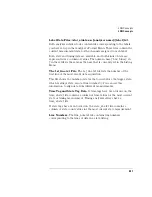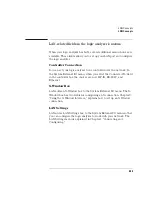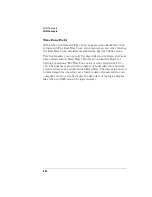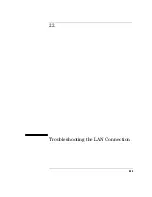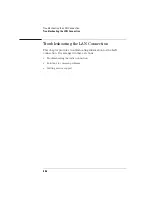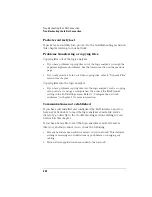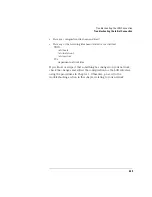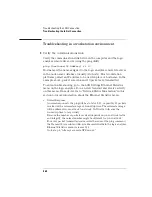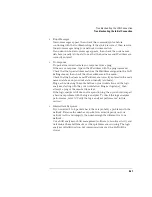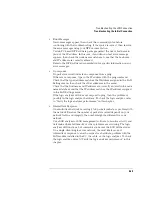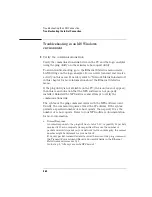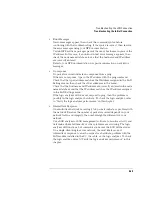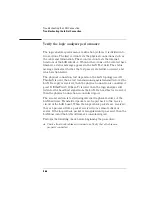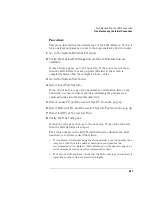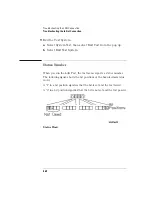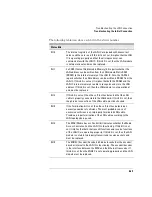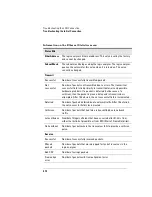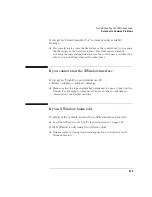
560
Troubleshooting the LAN Connection
Troubleshooting the Initial Connection
Troubleshooting in a workstation environment
1
Verify the communications link.
Verify the communications link between the computer and the logic
analyzer remote file server using the ping utility.
ping [hostname|IP Address] 64 10
Hostname is the name assigned to the logic analyzer remote file server
in the node names database (usually /etc/hosts). Most workstation
platforms permit an IP address to be used in place of hostname. In the
example above, packet size is 64 and 10 packets are transmitted.
To aid in troubleshooting, go to the LAN Settings Ethernet Statistics
menu on the logic analyzer. You can view transmit and receive activity
on this menu. If needed, refer to "Network Status Information" in this
section for more information about the Ethernet Statistics menu.
•
Normal Response
A normal response to the ping will be a total of 9, 10, or possibly 11 packets
received with a minimal average of round-trip time. The minimal average
will be different from network to network. LAN traffic will cause the
round-trip time to vary widely.
Because the number of packets received depends on your network traffic
and integrity, the normal number might be different for your network.
For every packet transmitted and received because of the ping command,
the Transmit Successful and Receive Successful fields in the logic analyzer
Ethernet Statistics menu increases by 1.
Go to step 2, "Attempt a remote NFS mount."
Summary of Contents for 1670E Series
Page 6: ...6 In This Book...
Page 26: ...26 Contents...
Page 27: ...27 Section 1 Logic Analyzer...
Page 28: ...28...
Page 29: ...29 1 Logic Analyzer Overview...
Page 39: ...39 2 Connecting Peripherals...
Page 49: ...49 3 Using the Logic Analyzer...
Page 72: ...72 Using the Logic Analyzer The Inverse Assembler...
Page 73: ...73 4 Using the Trigger Menu...
Page 101: ...101 5 Using the Oscilloscope...
Page 151: ...151 6 Using the Pattern Generator...
Page 199: ...199 7 Triggering Examples...
Page 237: ...237 8 File Management...
Page 249: ...249 9 Logic Analyzer Reference...
Page 360: ...360 Logic Analyzer Reference The Compare Menu...
Page 361: ...361 10 System Performance Analysis SPA Software...
Page 397: ...397 11 Logic Analyzer Concepts...
Page 430: ...430 Logic Analyzer Concepts The Analyzer Hardware Oscilloscope board theory Oscilloscope board...
Page 439: ...439 12 Troubleshooting the Logic Analyzer...
Page 455: ...455 13 Specifications...
Page 471: ...471 14 Operator s Service...
Page 479: ...479 Operator s Service Troubleshooting Troubleshooting Flowchart 2...
Page 491: ...491 Section 2 LAN...
Page 492: ...492...
Page 493: ...493 15 Introducing the LAN Interface...
Page 497: ...497 16 Connecting and Configuring the LAN...
Page 506: ...506 Connecting and Configuring the LAN Connecting and Configuring the LAN...
Page 507: ...507 17 Accessing the Logic Analyzer File System Using the LAN...
Page 515: ...515 18 Using the LAN s X Window Interface...
Page 527: ...527 19 Retrieving and Restoring Data Using the LAN...
Page 539: ...539 20 Programming the Logic Analyzer Using the LAN...
Page 546: ...546 Programming the Logic Analyzer Using the LAN Programming the Logic Analyzer Using the LAN...
Page 547: ...547 21 LAN Concepts...
Page 555: ...555 22 Troubleshooting the LAN Connection...
Page 580: ...580 Troubleshooting the LAN Connection Getting Service Support...
Page 581: ...581 Section 3 Symbol Utility...
Page 582: ...582...
Page 583: ...583 23 Symbol Utility Introduction...
Page 588: ...588 Symbol Utility Introduction Symbol Utility Introduction...
Page 589: ...589 24 Getting Started with the Symbol Utility...
Page 597: ...597 25 Using the Symbol Utility...
Page 609: ...609 26 Symbol Utility Features and Functions...






